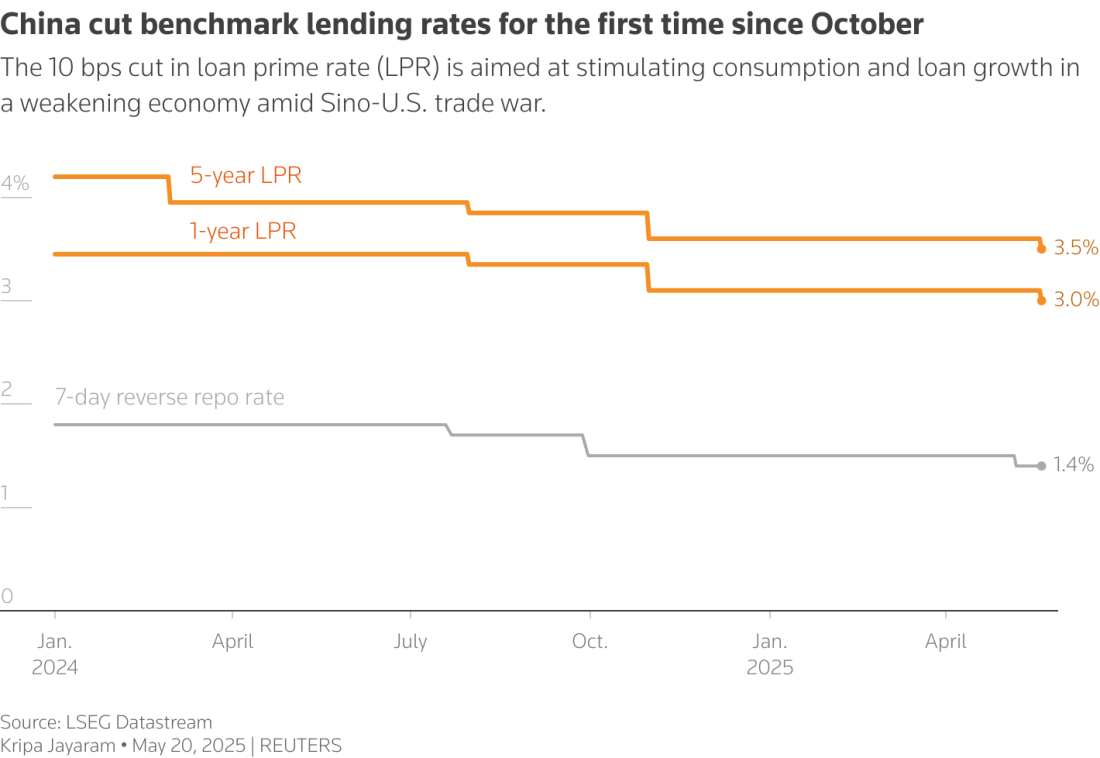Europe set to launch international commission for Ukraine war damages
Leaders including Ukraine's Volodymyr Zelenskyy arrived at The Hague on Tuesday to launch an International Claims Commission to compensate Kyiv for hu...
China cut benchmark lending rates for the first time since October on Tuesday, while major state banks lowered deposit rates as authorities work to ease monetary policy to help buffer the economy from the impact of the Sino-U.S. trade war.
The widely expected rate cuts are aimed at stimulating consumption and loan growth as the world's No. 2 economy softens, while still protecting commercial lenders' shrinking profit margins.
Still, the size of the rate reductions was mild and reflected the incremental pace of monetary easing in recent years and what analysts interpreted as some wariness among policymakers for more aggressive steps while they navigate the trade war with the United States.
The People's Bank of China said the one-year loan prime rate (LPR), a benchmark determined by banks, had been lowered by 10 basis points to 3.0% , while the five-year LPR was reduced by the same margin to 3.5%.
Most new and outstanding loans in China are based on the one-year LPR, while the five-year rate influences the pricing of mortgages. Both rates are now at the lowest level since China ravamped the LPR mechanism in 2019.

The lending rate cut was announced just after five of China's biggest state-owned banks said they had trimmed their deposit interest rates.
Industrial and Commercial Bank of China (601398.SS), opens new tab, Agricultural Bank of China (601288.SS), China Construction Bank (601939.SS), and Bank of China (601988.SS) reduced deposit rates by 5-25 basis points (bps) for some tenors, according to rates shown on the banks' mobile apps. Reuters had reported on Monday that the banks planned to cut their deposit rates from Tuesday.
The deposit rate reductions should guide smaller lenders in making similar cuts.
Banking shares edged higher following the rate decision, with the CSI Bank Index (.CSI399986) rising 0.3%.
Marco Sun, chief financial market analyst at MUFG Bank (China), said the rate cuts were aimed at boosting credit lending and stimulating consumption.
Russia’s human rights commissioner, Tatyana Moskalkova, has said that Ukraine has not provided Moscow with a list of thousands of children it alleges were taken illegally to Russia, despite the issue being discussed during talks in Istanbul.
Syrian President Ahmad al-Sharaa has offered condolences to President Donald Trump following an ISIS attack near the ancient city of Palmyra that killed two U.S. soldiers and a civilian interpreter, Syrian and U.S. officials said Sunday.
At least 17 people, including students, were killed and 20 others injured after a school bus fell off a cliff in northern Colombia on Sunday, authorities said.
At least 37 people have been killed in flash floods triggered by torrential rain in Morocco's Atlantic coastal province of Safi, Moroccan authorities said on Monday (15 December).
At least 37 people have died and dozens of others were injured after flash floods swept through Morocco’s Atlantic coastal city of Safi on Sunday, authorities said.
Ford Motor Company said on Monday it will take a $19.5 billion writedown and scrap several electric vehicle (EV) models, marking a major retreat from its battery-powered ambitions amid declining EV demand and changes under the Trump administration.
Iran has rolled out changes to how fuel is priced at the pump. The move is aimed at managing demand without triggering public anger.
U.S. stock markets closed lower at the end of the week, as investors continued to rotate out of technology shares, putting pressure on major indices.
The U.S. Federal Reserve’s Federal Open Market Committee (FOMC) cut its benchmark interest rate by 25 basis points to a range of 3.50% to 3.75% following its two-day policy meeting, according to an official statement issued on Wednesday, 10 December.
China has carried out a major test of a new “super wireless” rail convoy, a technology that could reshape the future of heavy-haul transport.
You can download the AnewZ application from Play Store and the App Store.

What is your opinion on this topic?
Leave the first comment